Bajaj Pulsar NS
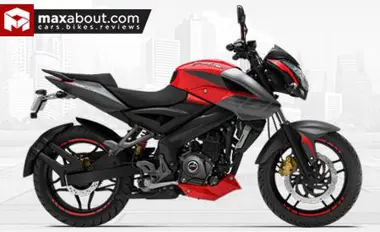




POPULARITY
- This week: 1079 views
- All time: 5714 views
Expected Price
| 2-Wheeler Type | Naked |
| Engine cc (Displacement) | 199.5 cc |
| Maximum Power | 24.5 HP @ 9750 rpm |
| Maximum Torque | 18.7 Nm @ 8000 rpm |
| Number of Cylinders | 1 |
| Number of Gears | 6 |
| Seat Height | 805 mm |
| Ground Clearance | 168 mm |
| Kerb Weight | 158 kg |
| Fuel Tank Capacity | 12 litres |
Pros
-
Good Looks
(333 of 387 agree)
-
Advanced Technology
(230 of 291 agree)
-
Powerful Engine
(246 of 283 agree)
-
Good Value for Money
(221 of 275 agree)
-
Vast Service Network
(178 of 229 agree)
-
Good Mileage
(189 of 292 agree)
Cons
-
Doubtful Build Quality
(123 of 203 agree)
-
High Seat Height
(156 of 233 agree)
Our take on this /// Verdict
The Bajaj Pulsar NS200 is a sporty bike that is affordable and fun to ride. It has a strong engine that makes it fast, and it looks cool with its sharp design. You will feel comfortable when you ride it, whether it is for daily traveling or some thrilling adventures.
Price
2023 Bajaj Pulsar NS200 price is Rs 1.49 lakh in India (ex-showroom). The Naked Bajaj Pulsar NS200 (new model) is available in 4 color options i.e., Glossy Ebony Black, Metallic Pearl White, Cocktail Wine Red – White, and Pewter Grey – Blue.
Latest Updates
Bajaj Auto has updated the colour palette for its 200cc roadster-segment motorcycle, the Pulsar NS200, in the Indian market with the addition of the Cocktail Wine Red and Pewter Grey paint themes. With these, the Pulsar NS200 is now available in four colours – Ebony Black, Pearl Metallic White, Cocktail Wine Red, and Pewter Grey.
Colour Options and Price in India | |
| Bike Variant | Bajaj Pulsar NS200 (New Model) |
| Availability Status in India | Available |
| 2-Wheeler Type | Naked |
| Latest Price in India | Bajaj Pulsar NS200 price is Rs 1.49 lakh (ex-showroom). |
| Fuel Type | Petrol |
| Colour Options | Glossy Ebony Black, Metallic Pearl White, Cocktail Wine Red – White, Pewter Grey – Blue |
| Official Tagline | Leaner. Meaner. Quicker. |
| On Road Price | Bajaj Pulsar NS200 on road price is Rs 1.72 lakh in Delhi, Rs 1.78 lakh in Mumbai, Rs 1.74 lakh in Kolkata and Rs 1.76 lakh in Chennai. The prices mentioned here are approximate and we suggest you contact your nearest Bajaj dealership to get the exact on-road price quote in your city. |
MAXABOUT RATING AND OVERVIEW | |
| Design | |
| Performance | |
| Comfort | |
| Fuel Economy | |
| Features | |
| Build Quality | |
| Value for Money | |
| Should You Buy It? | Definitely as no other motorcycle at this price has the power to sprint ahead of NS200 in any condition. |
ENGINE AND GEARBOX | |
| Engine Details | 199.5cc, Liquid-Cooled, Triple Spark, 4-Valve FI DTS-i Engine |
| Fuel System | Fuel Injection |
| Cooling | Liquid Cooled |
| Engine cc (Displacement) | 199.5 cc |
| Maximum Power | 24.5 HP @ 9750 rpm |
| Maximum Torque | 18.7 Nm @ 8000 rpm |
| Number of Cylinders | 1 |
| Emission Norms | BS6-Compliant |
| Bore | 72 mm |
| Stroke | 49 mm |
| Valves Per Cylinder | 4 |
| Number of Gears | 6 |
| Gearbox Type | Multi-Plate Wet |
MILEAGE AND TOP SPEED | |
| Mileage | Bajaj Pulsar NS200 mileage is 35 kmpl (approximate). |
| Performance | In terms of performance, the 200cc streetfighter can accelerate from 0-100 kmph in 10.28 seconds. |
| Top Speed | Bajaj Pulsar NS200 top speed is 136 kmph (speedo-indicated). |
BRAKES AND TYRES | |
| Front Brake | 300mm Single Disc |
| Rear Brake | 230mm Single Disc |
| ABS | 2-Channel |
| Front Tyre | 100/80-17 52P |
| Rear Tyre | 130/70-17 62P |
| Wheel Type | 10 Spoke Alloys |
| Tubeless Tyres | |
| Alloy Wheels | |
PERFORMANCE FIGURES | |
| 0-60 kmph | 3.87 secs |
| 0-100 kmph | 10.28 secs |
KEY FEATURES AND COMPETITORS | |
| Braking System | 2-Channel ABS (Anti-lock Braking System) |
| Similar Bikes | TVS Apache RTR 200 4V, KTM Duke 200, KTM RC 200, Honda Hornet 2.0, Yamaha FZ-25, Hero Xtreme 200R |
SUSPENSION AND CHASSIS | |
| Front Suspension | Up Side Down Fork |
| Rear Suspension | Nitrox Mono Shock Absorber with Canister |
| Frame (Chassis) | Perimeter |
DIMENSIONS AND WEIGHT | |
| Overall Length | 2017 mm |
| Overall Width | 804 mm |
| Overall Height | 1075 mm |
| Ground Clearance | 168 mm |
| Seat Height | 805 mm |
| Wheelbase | 1363 mm |
| Kerb Weight | 158 kg |
| Fuel Tank Capacity | 12 litres |
INSTRUMENT CONSOLE FEATURES | |
| Speedometer | Digital |
| Tachometer | Analogue |
| Trip Meter | Digital |
| Odometer | Digital |
| Clock | Digital |
| ABS Light | |
| Fuel Gauge | Digital |
| Gear Indicator | |
| Distance To Empty | |
BATTERY AND LIGHTING | |
| Pass Light | |
| Battery Type | Maintenance Free, VRLA |
| Capacity | 8Ah |
| Voltage | 12V |
| Head Light | H4 BLUE TINGE (12V 55/60W) |
| Tail Light | LED |
| Auxiliary Light | |
| Automatic Headlamp On (AHO) | |
COMFORT FEATURES | |
| Electric Start | |
| Pillion Footrest | |
| Step-up Seat/Split Seat | |
Miscellaneous Information | |
| Ex Showroom Price vs On Road Price | Ex-Showroom Price is the Manufacturing Cost of the vehicle + Dealer/Seller Profit + GST (Goods and Service Tax) + Transportation Charges (from the manufacturing plant to the dealership). On the other hand, the On-Road Price is the actual cost you pay to the dealership to make the vehicle legal to run on the roads. It includes Ex-Showroom Price in your city + RTO Charges (Vehicle Registration) + One Time Road Tax + Insurance Charges. The On-Road Price also includes some optional things like if you opt for Genuine Accessories and Extended Warranty while buying a vehicle. Please note that the On-Road Price varies a lot across different states in India due to different percentage for the State Registration Charges. |
Latest Bajaj Pulsar NS News
Recently Added News
Latest News
Recently Added News
Bajaj Pulsar NS Videos



Bajaj Pulsar NS Review
Overview
The Bajaj Pulsar NS200 is a well-known motorcycle in India, praised for its sporty look, strong engine, and great overall performance. Aimed at young riders and those who love speed, this bike offers an exciting ride without breaking the bank. In this review, we will explore its design, performance, features, and the riding experience it provides.
Key Takeaways
- The Pulsar NS200 has a striking and aggressive design that stands out on the road.
- Powered by a 199.5cc engine, it delivers impressive performance and quick acceleration.
- The bike is designed for comfort and handling, making it great for both city and highway rides.
- It includes useful features like a digital display and Bluetooth connectivity for added convenience.
- With a competitive price range, it offers good value for money compared to its rivals.
Design and Build Quality of Bajaj Pulsar NS
Aggressive Streetfighter Aesthetics
The Bajaj Pulsar NS200 stands out with its bold and aggressive design. Its sharp lines and muscular fuel tank give it a sporty look that appeals to young riders. The bike features a streetfighter stance, which includes:
- A split seat setup
- An underbelly exhaust
- Stylish alloy wheels
Material Quality and Finish
When it comes to build quality, the Pulsar NS200 impresses with its robust frame and high-quality materials. The fit and finish are commendable, making it look premium for its price range. The use of durable plastics throughout the bike ensures longevity and reliability.
Ergonomics and Comfort
Riding the Pulsar NS200 is a comfortable experience. The bike is designed to provide:
- A relaxed riding position
- Good handlebar reach
- Comfortable seat cushioning
The Bajaj Pulsar NS200 combines style and comfort, making it a great choice for both city commuting and longer rides.
Engine Performance and Specifications
Engine Configuration and Output
The Bajaj Pulsar NS200 is powered by a 199.5cc, single-cylinder, liquid-cooled engine. It produces about 24.5 PS at 9750 rpm and a peak torque of 18.5 Nm at 8000 rpm. This setup ensures a thrilling ride, making it suitable for both city commuting and highway cruising.
Transmission and Gearbox
The bike features a smooth six-speed gearbox that allows for quick and precise gear shifts. This enhances the overall riding experience, especially during high-speed rides.
Fuel Efficiency and Mileage
The Pulsar NS200 offers decent fuel efficiency, making it a practical choice for daily use. Here’s a quick look at its mileage:
| Riding Condition | Mileage (km/l) |
|---|---|
| City | 35-40 |
| Highway | 40-45 |
The Bajaj Pulsar NS200 combines performance with efficiency, making it a popular choice among riders.
In summary, the Bajaj Pulsar NS200 stands out with its powerful engine, smooth transmission, and reasonable fuel efficiency, making it a well-rounded motorcycle for various riding conditions.
Riding Experience and Handling
Suspension Setup and Comfort
The Bajaj Pulsar NS offers a well-balanced suspension system that enhances comfort during rides. The front features telescopic forks, while the rear has a monoshock setup. This combination allows for a smooth ride over bumps and uneven surfaces. Riders often appreciate the comfort level, especially on longer journeys.
Braking System and Safety
Safety is a priority with the Pulsar NS, equipped with a reliable braking system. It includes:
- Front disc brake for quick stopping power.
- Rear disc brake for added safety.
- Optional ABS (Anti-lock Braking System) for better control during sudden stops.
City and Highway Performance
The Pulsar NS performs admirably in both city and highway conditions. In the city, it is agile and easy to maneuver through traffic. On highways, it maintains stability at higher speeds. Here’s a quick comparison of its performance:
| Feature | City Performance | Highway Performance |
|---|---|---|
| Maneuverability | Excellent | Good |
| Stability at Speed | Fair | Excellent |
| Comfort Level | High | Moderate |
The Bajaj Pulsar NS is designed to provide a versatile riding experience, making it suitable for various riding conditions.
Technological Features and Innovations
Digital Instrument Cluster
The Bajaj Pulsar NS200 features a semi-digital instrument console that provides essential information to the rider. It includes a digital speedometer, fuel gauge, and a low fuel indicator. However, it lacks modern features like Bluetooth connectivity and a fully digital display.
| Feature | Availability |
|---|---|
| Digital Speedometer | Yes |
| Digital Fuel Gauge | Yes |
| Call/SMS Alerts | No |
| Distance to Empty | Yes |
| Gear Indicator | Yes |
| Service Reminder Indicator | Yes |
Bluetooth Connectivity
Unfortunately, the Pulsar NS200 does not come with Bluetooth connectivity. This means riders miss out on features like call notifications and navigation assistance that are available in some competitor models. The absence of this feature may be a drawback for tech-savvy riders looking for a more connected experience.
Lighting and Indicators
The motorcycle is equipped with halogen headlights and LED brake lights. While it has daytime running lights (DRLs), it does not feature modern lighting options like LED headlights. Here are some key points about its lighting:
- Halogen headlight for better visibility at night.
- LED brake lights for improved safety.
- Daytime Running Lights (DRLs) enhance visibility during the day.
The Bajaj Pulsar NS200 offers a solid set of features, but it falls short in the tech department compared to its rivals. Riders looking for advanced technological features may find it lacking.
Pricing and Variants in India
Ex-Showroom Prices
The Bajaj Pulsar NS200 is available at different prices across various cities in India. Here’s a quick look at the ex-showroom prices:
| City | Price (INR) |
|---|---|
| Mumbai | ? 1,71,745 |
| Bangalore | ? 1,83,403 |
| Delhi | ? 1,67,083 |
| Pune | ? 1,69,219 |
| Hyderabad | ? 1,70,784 |
| Chennai | ? 1,67,749 |
| Kolkata | ? 1,72,381 |
| Lucknow | ? 1,72,949 |
On-Road Prices in Major Cities
The on-road prices can vary based on additional costs like road tax and insurance. Here’s a breakdown of the on-road prices in some major cities:
- Mumbai: ? 1,83,000
- Bangalore: ? 1,95,000
- Delhi: ? 1,80,000
- Pune: ? 1,82,000
Available Variants
The Bajaj Pulsar NS200 comes in a few variants, catering to different preferences:
- Standard Variant: Basic features with a focus on performance.
- ABS Variant: Includes Anti-lock Braking System for enhanced safety.
- Special Edition: Unique color schemes and additional features.
The Bajaj Pulsar NS200 offers a great balance of performance and affordability, making it a popular choice among riders in India.
User Reviews and Ratings
Overall User Satisfaction
Many riders have shared their experiences with the Bajaj Pulsar NS, and the feedback is mostly positive. Most users appreciate the bike's design and performance. Here are some common points from user reviews:
- Stylish and aggressive look
- Smooth engine performance
- Good value for money
Common Praises and Complaints
Users often highlight both the strengths and weaknesses of the Bajaj Pulsar NS. Here’s a summary:
Praises:
- Excellent design and build quality
- Reliable performance
- Comfortable for short rides
Complaints:
- Limited comfort on long rides
- Some issues with service experience
- Fuel efficiency could be better
Expert Reviews
Experts have also weighed in on the Bajaj Pulsar NS. Here’s a quick look at their ratings:
| Rating Parameter | Score (out of 5) |
|---|---|
| Design and Styling | 5 |
| Reliability | 5 |
| Comfort | 4 |
| Service Experience | 4 |
| Value for Money | 5 |
Overall, the Bajaj Pulsar NS is well-received in the market, making it a popular choice among riders.
Comparison with Competitors
Bajaj Pulsar NS200 vs TVS Apache RTR 200 4V
The TVS Apache RTR 200 4V is a strong competitor to the Bajaj Pulsar NS200. With a powerful engine and modern features, it appeals to many riders. Here’s a quick comparison:
| Feature | Bajaj Pulsar NS200 | TVS Apache RTR 200 4V |
|---|---|---|
| Engine Displacement | 199.5 cc | 197.75 cc |
| Power Output | 24.16 bhp | 20.54 bhp |
| Fuel Efficiency | 34.5 kmpl | 38 kmpl |
| Ex-Showroom Price | ? 1,49,916 | ? 1,49,916 |
Bajaj Pulsar NS200 vs Yamaha FZS FI V4
The Yamaha FZS FI V4 is known for its stylish design and good mileage. Here’s how it stacks up against the Pulsar NS200:
| Feature | Bajaj Pulsar NS200 | Yamaha FZS FI V4 |
|---|---|---|
| Engine Displacement | 199.5 cc | 149 cc |
| Power Output | 24.16 bhp | 12.2 bhp |
| Fuel Efficiency | 34.5 kmpl | 48 kmpl |
| Ex-Showroom Price | ? 1,49,916 | ? 1,29,992 |
Bajaj Pulsar NS200 vs Bajaj Dominar 250
The Bajaj Dominar 250 offers a different riding experience with its larger engine. Here’s a brief comparison:
| Feature | Bajaj Pulsar NS200 | Bajaj Dominar 250 |
|---|---|---|
| Engine Displacement | 199.5 cc | 248.77 cc |
| Power Output | 24.16 bhp | 27 bhp |
| Fuel Efficiency | 34.5 kmpl | 30 kmpl |
| Ex-Showroom Price | ? 1,49,916 | ? 1,70,000 |
The Bajaj Pulsar NS200 stands out for its sporty design and performance, but it faces tough competition from models like the TVS Apache and Yamaha FZS. Each bike has its own strengths, making it essential for buyers to consider their personal preferences.
Maintenance and Ownership Costs
Service Intervals and Costs
The Bajaj Pulsar NS is known for its affordable maintenance costs. Regular service costs range from 1000 to 1200 INR. Here’s a quick overview of typical service needs:
- Chain Sprocket: Changed once in 65,000 km
- Brake Pads: Replaced twice in the same distance
- Clutch Cable: Changed once
Spare Parts Availability
Spare parts for the Bajaj Pulsar NS are generally easy to find. This is beneficial for owners who want to keep their bikes in top shape without spending too much time or money.
Long-Term Reliability
Many users report that the bike maintains a good mileage of around 38-40 km/l, even after years of use. This consistency is a strong point for the Pulsar NS, making it a reliable choice for daily commuting.
The Bajaj Pulsar NS is like a trusted friend; the more you ride it, the more you appreciate its strengths.
Overall, the Bajaj Pulsar NS offers a balance of low maintenance costs and reliable performance, making it a popular choice among riders.
Pros and Cons of Bajaj Pulsar NS
Strengths and Advantages
- Sporty and aggressive design that attracts attention.
- Powerful engine with a smooth performance.
- Excellent handling and stability, making it easy to ride.
- Good build quality that feels durable.
- Impressive fuel efficiency, averaging around 35-40 kmpl.
Weaknesses and Drawbacks
- Lacks some modern features like a slipper clutch.
- Can experience vibrations at higher RPMs.
- The suspension may feel a bit firm for some riders.
Ideal Use Cases
- Great for daily commuting due to its fuel efficiency.
- Suitable for young riders looking for a sporty bike.
- Good for both city rides and occasional highway trips.
The Bajaj Pulsar NS200 is a well-rounded motorcycle that balances performance and style, making it a popular choice among riders.
Market Position and Popularity
Target Audience
The Bajaj Pulsar NS200 is aimed at young riders who seek a blend of performance and style. Its sporty design and powerful engine make it a favorite among:
- College students
- Young professionals
- Motorcycle enthusiasts
Sales Performance in India
The Pulsar NS200 has consistently performed well in the Indian market. Here’s a quick look at its sales figures compared to some competitors:
| Model | Avg. Ex-Showroom Price | Sales Performance |
|---|---|---|
| Bajaj Pulsar NS200 | ? 1,42,060 | High |
| TVS Apache RTR 200 4V | ? 1,23,752 | Moderate |
| Yamaha FZS FI V4 | ? 1,29,992 | Moderate |
Global Market Presence
The Pulsar brand, including the NS200, has a strong presence not just in India but also in several international markets. This global reach enhances its reputation and popularity.
The Bajaj Pulsar NS200 remains a top choice for many riders, thanks to its thrilling performance and stylish looks. Its enduring popularity is a testament to its quality and appeal.
Overall User Satisfaction
User reviews indicate a high level of satisfaction with the Pulsar NS200. Key points include:
- Performance: Riders love its powerful engine.
- Design: The aggressive look attracts many.
- Comfort: Good ergonomics for long rides.
In summary, the Bajaj Pulsar NS200 holds a significant position in the market, appealing to a wide range of riders and maintaining strong sales performance.
Future Updates and Expectations
Upcoming Features
- Enhanced Digital Instrument Cluster: The next version may include a more advanced digital display with Bluetooth connectivity.
- Improved Lighting: Future models could feature LED lighting for better visibility and style.
- Smartphone Integration: There are expectations for apps that connect to the bike for notifications and navigation.
Potential Improvements
- Modern Styling: A refreshed design could attract younger riders.
- Advanced Safety Features: Adding features like traction control and cornering ABS would enhance safety.
- Better Comfort: Upgraded seating and suspension could improve long-distance riding comfort.
Market Trends and Predictions
- The demand for smart bikes is rising, pushing manufacturers to innovate.
- Competitors are introducing more features, which may prompt Bajaj to enhance the Pulsar NS.
- Sales Growth: With the right updates, Bajaj could see an increase in sales, especially among younger riders.
The Bajaj Pulsar NS has a strong legacy, but to stay relevant, it must adapt to the changing market and rider expectations.
Final Thoughts on the Bajaj Pulsar NS200
In conclusion, the Bajaj Pulsar NS200 stands out as a strong choice for riders in India. With its sporty look and powerful engine, it offers a thrilling ride for both city commuting and longer trips. The bike is well-built, making it reliable and enjoyable to ride. Although it could use some modern features, its performance and comfort make it a great value for the price. Overall, if you're looking for a bike that combines style, power, and affordability, the Pulsar NS200 is definitely worth considering.
Frequently Asked Questions
What is the price of the Bajaj Pulsar NS200 in India?
The Bajaj Pulsar NS200 starts at around ?1,42,060 in India, but prices can vary by city.
How powerful is the engine of the Bajaj Pulsar NS200?
The Pulsar NS200 has a 199.5cc engine that produces about 24.13 bhp.
What is the fuel efficiency of the Bajaj Pulsar NS200?
You can expect a mileage of around 36 kmpl from the Bajaj Pulsar NS200.
How does the Bajaj Pulsar NS200 handle on the road?
The bike offers great handling, making it easy to ride in both city traffic and on highways.
What are the main features of the Bajaj Pulsar NS200?
It includes a digital instrument cluster, Bluetooth connectivity, and stylish LED lights.
What are the available variants of the Bajaj Pulsar NS200?
The Pulsar NS200 comes in multiple variants, including single-channel ABS and dual-channel ABS.
How do users rate the Bajaj Pulsar NS200?
It has an average rating of 4.7 out of 5 based on user reviews, highlighting its performance and design.
Is the Bajaj Pulsar NS200 suitable for long rides?
Yes, thanks to its comfortable seating and good suspension, it's great for long-distance travel.
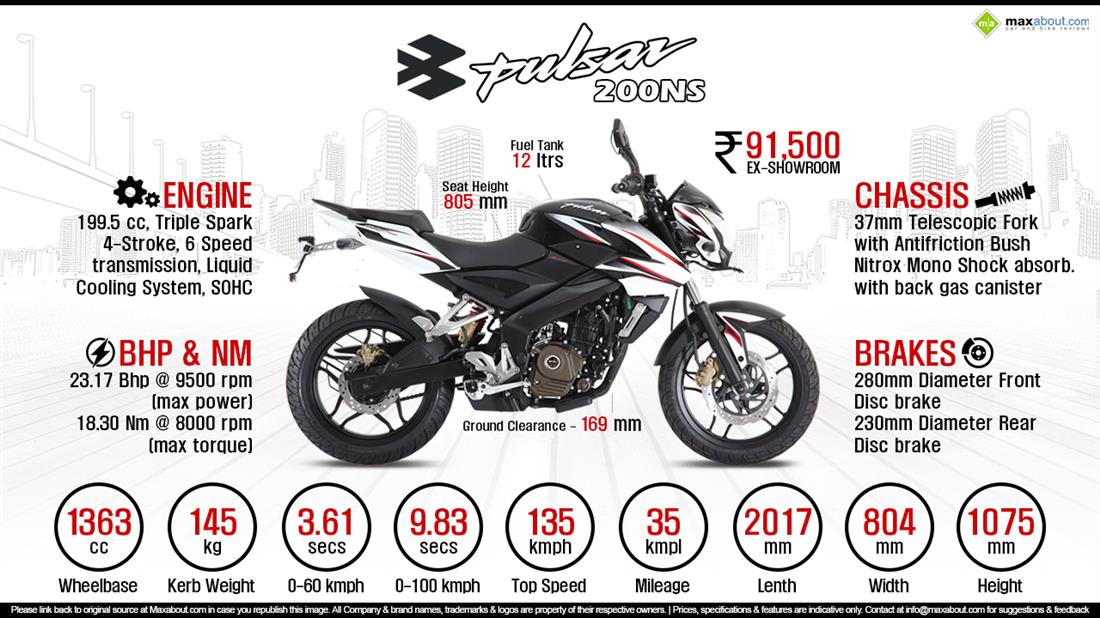
Colors
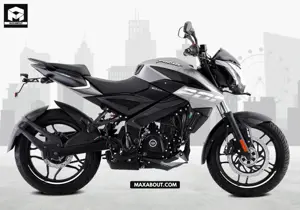
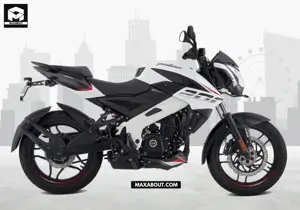
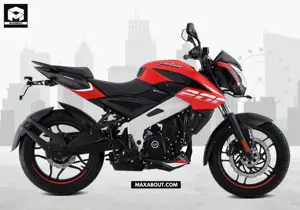
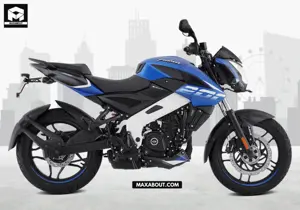
Discussions and Questions Bajaj Pulsar NS
Which one is better - Honda CBR150R or Bajaj Pulsar NS200?
The choice between the Honda CBR150R and the Bajaj Pulsar NS200 depends on several factors, including performance, features, and personal preferences. The Honda CBR150R is powered by a 149.16 cc engine, producing 17.1 PS of power at 9000 rpm and 14.4 Nm of torque at 7000 rpm. It features a 6-speed manual transmission, liquid-cooled engine, and dual-channel ABS. The bike has a kerb weight of 139 kg, a seat height of 782 mm, and a fuel tank capacity of 12 liters. It also boasts advanced features like an LED headlight, taillight, and turn signal lamps, along with a digital instrument console. In contrast, the Bajaj Pulsar NS200 comes with a 199.5 cc engine, delivering 24.5 PS of power at 9750 rpm and 18.74 Nm of torque at 8000 rpm. It has a 6-speed manual transmission and single-channel ABS. The Pulsar NS200 has a kerb weight of 159.5 kg, a seat height of 805 mm, and a fuel tank capacity of 12 liters. It also features a digital instrument cluster and LED DRLs, but lacks the advanced suspension and braking system of the CBR150R. If you prioritize higher power and torque, the Bajaj Pulsar NS200 might be the better choice. However, if you prefer a more agile and feature-rich sports bike with better handling and braking, the Honda CBR150R could be more suitable. The CBR150R's lower weight and advanced suspension make it more appealing for those who value maneuverability and comfort in a sports bike[5).
What would the on-road price of Bajaj Pulsar NS150?
The on-road price of the Bajaj Pulsar N150 in India starts at around Rs. 1,47,812 in Delhi, inclusive of RTO charges and insurance. This price is based on the ex-showroom price of Rs. 1,24,730 to Rs. 1,25,742, depending on the variant and city-specific costs.
What would be the mileage of Bajaj Pulsar NS180?
The Bajaj Pulsar 180, often referred to in the context of its mileage, is reported to have a real-world mileage of around 42-44 kmpl. This is based on user reports and reviews, which consistently mention a mileage range of 42 to 45 kmpl, depending on riding conditions and maintenance of the bike[5).
What is the Exact Mileage of Bajaj Pulsar NS200?
The Bajaj Pulsar NS200 has an ARAI claimed mileage of 40.36 kmpl. However, based on user reports, the real-world mileage is approximately 36 kmpl. This variation is due to factors such as riding conditions, maintenance, and driving style. The bike's fuel efficiency is considered good for its segment, with some users reporting mileage ranging from 32-40 kmpl depending on whether they are riding in city or highway conditions[5).
Can I travel 500 km non stop on Bajaj Pulsar NS200?
Traveling 500 km non-stop on the Bajaj Pulsar NS200 is not feasible due to several factors. The bike has a fuel tank capacity of 12 liters and an average mileage of 40.36 kmpl, which translates to a range of approximately 350-400 km with a full tank, depending on the riding style. Additionally, the bike's design and comfort features are not optimized for long, continuous rides without breaks. It is recommended to take regular breaks for rest, fuel, and maintenance to ensure both the rider's safety and the bike's performance[5).
View All Bajaj Pulsar NS Discussions
Ask a Question
Featured Bajaj Comparisons
User Reviews for Bajaj Pulsar NS
Overall Good Bike
It's indeed a good machine, but Bajaj should consider updating the Bajaj 160 as it remains underrated. The bike lacks sufficient pulling power and features, even though its ergonomics are decent. Surprisingly, it has not gained much attention from aftermarket accessory companies. Simply adding USD (Upside-Down) forks and new colors won't be enough to update it effectively. This machine requires substantial changes to its console, suspensions, and internal configurations. Personally, I plan to upgrade it by adding a BMC air filter to address the throttle response, which is currently inadequate and laggy. Additionally, some suspension adjustments are necessary as it lacks stability on long roads.
Great pickup and speed
Bajaj pulsar is one of the best bike introduce by bajaj... It has great mileage, pickup and power as well. I am using this bike since last 4 years and still it looks like new only. While going for servicing at service center, it does not cost me much as it has less maintenance. Truly amazing this bike is. Loved it.
My experience with pulsar150
My elder brother bought brand new pulsar 150 in 2010 and when i saw it i feel wooo i use to ride it. This is great bike for daily users and touring(100-250) great handling and good breaking system. Bike performance well within60-80kmpl. You can ride with pillion very comfortably. If we talk about the looks its looks good i have black edition of the 150. Servicing and maintenance is all about how you maintain your bike by at all it is very cheap you can easily afford. I think it is the king of the 150 segment. You easily maintain the bike and have great ownership experiences as i have(10years)..

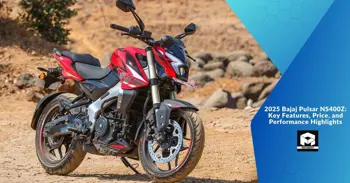
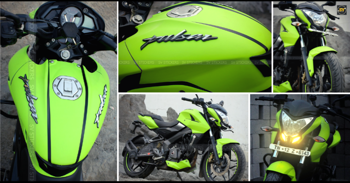

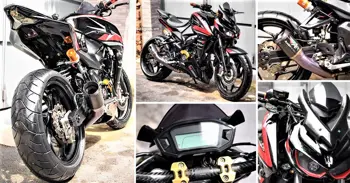

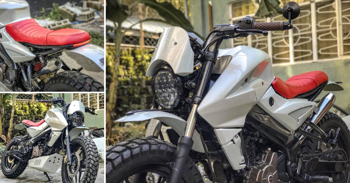
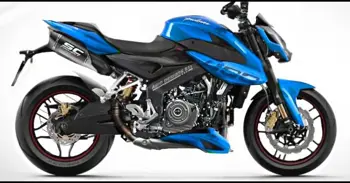
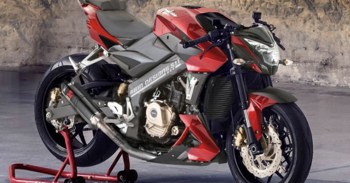



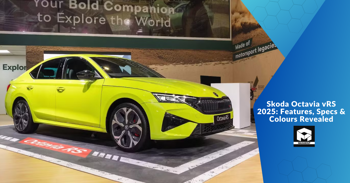
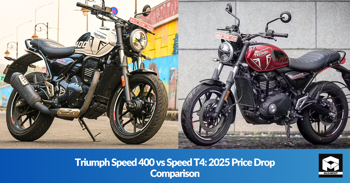
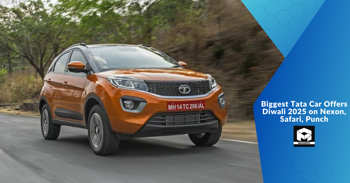
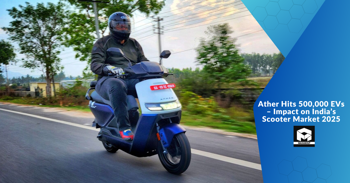
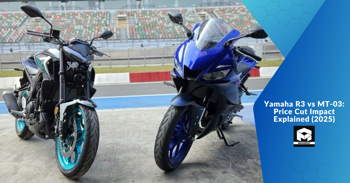
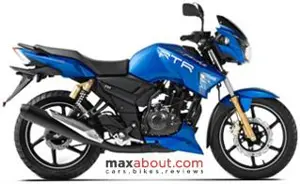
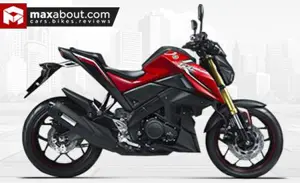
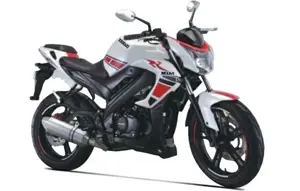
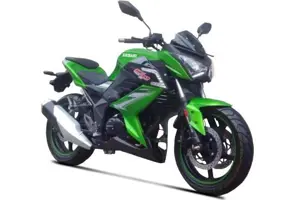

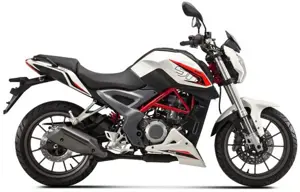
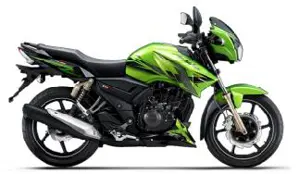
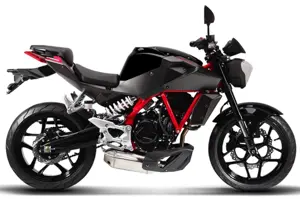
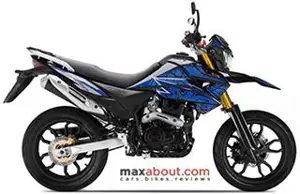
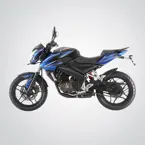
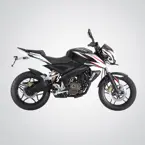
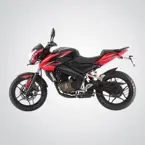

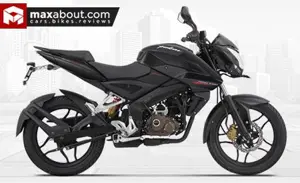

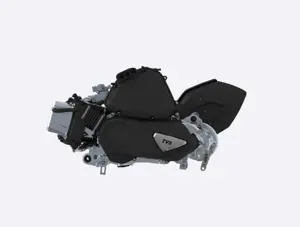
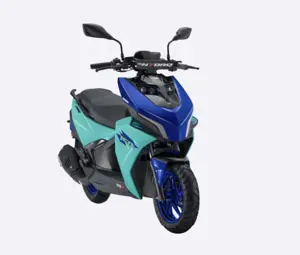
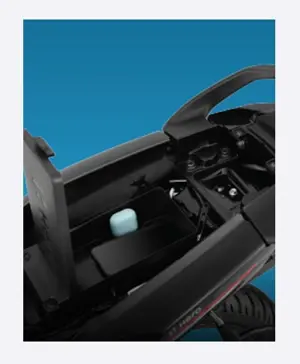
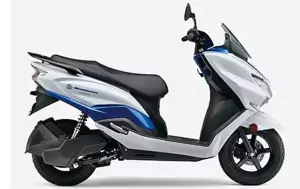
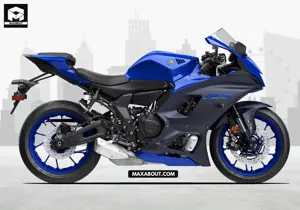
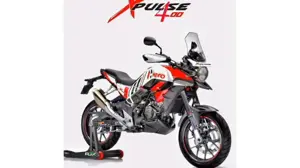
Bajaj Pulsar NS Discussion
Post a Comment